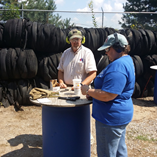As I type the title I realize that in 6 months folks will scan the index on the right side of the blog and have no clue what it means. There will be other “Virginias” by then . . . But, for today and the next few days the “tragedy in Virginia” is wall to wall.
As an individual that has chosen to carry a defensive handgun for personal defense, as an instructor who has chosen to train folks in a skill set that provides them a chance at defending themselves, their family or someone in their charge and as a member of a broader training community . . . the “tragedy in Virginia” deserves some of our time.
To begin with, I’d like to simply point out that this wasn’t a “tragedy in Virginia”. This was a cold blooded murder carried out in a deliberate and purposeful way, a clear and deliberate act of evil. It wasn’t an accident, an act of God, a death due to an errant act on the part of Alison Parker or Adam Ward. It was a clear manifestation of evil in our time – period.
I read lots of comments about “situational awareness” – seemingly saying that had Ms. Parker and Mr. Ward only been “aware” of their surroundings . . . things may have turned out differently. That fact was that they were, indeed, “aware”. They were aware of the job they were sent to do. Ms. Parker was aware of the woman she was interviewing and was totally and professionally focused on her – as she should have been. Mr. Ward was also aware of the reason he was there – to deliver the best video shot he could for has news station. Their head was fully and totally “in the game” – performing the job professionally and to the very best of their ability. There is no fault there on their part and I find off the cuff comments about “situational awareness” in the context of them doing their job frankly offensive.
The shooter had a history of offensive behavior that had gotten him fired a number of times. From what I read a handful of random comments by Ms. Parker attracted his attention and seemingly sealed her fate. I also find I am exhausted to the ready excuse that he had “mental problems”. Given the effort he had to put into purchasing the weapon (as well as stockpiling more in his car), finding out the time of the interview, traveling to the interview, moving up on them from their blind spot . . . I see little evidence of a lack of mental ability. What he lacked was a moral compass. What he seems to have done is to have bought into the current arguments of whites being modern day slave owners and that “they” continue to abuse the black community. What he seems to have accepted is that the killing of Ms. Parker and Mr. Ward was justified because he had been “insulted”. Sadly, this type of rhetoric can be heard on a daily basis from social media to the main stream press. And it is becoming more and more affective in inciting black on white and black on law enforcement violence. I do not believe Ms. Parker or Mr. Ward will be the last of these types of assassinations.
As an aside, since their killing two police officers have also been assassinated as well. There are days when I feel like we are very close to the wheels coming well and full off the wagon. Time will tell if sanity rules or we will all just have to wait to see who the last folks standing are.
There is one other lesson to learn here as well. It may be hard to hear, difficult to accept . . . yet I believe it is true.
We all have our day.
Regardless of our training, regardless of our course work, regardless of our efforts . . . we all have our day. Whether we are on the deck of a boat club or sitting in our recliner after a fine meal . . . For whatever reason – it arrived for Ms. Parker and Mr. Ward last week. It is something we all need to remember. That does NOT mean to just pack it in, skip the range and say “screw it”. What it does mean is to live your life every day! And, I am grateful to hear that it appears Ms. Parker and Mr. Ward had lived and loved and given to all in their life. In the end – that is what they should be remembered for.
I pray for the peace of their souls and for those in their lives . . .
Bill Keller
Founding Member M.A.P.S.I.









